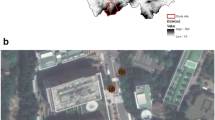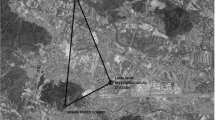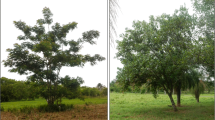Abstract
Afforestation is inserted in the urban environment and interferes directly in the surface runoff. In order to quantify the rainfall interception by tree species, an experiment was carried out in the city of Uruaçu, Goiás, Brazil, with the four most common tree species in the urban afforestation of the region. The species chosen were the Mangifera indica (mango tree), the Caesalpinia peltophoroides (sibipiruna tree), the Pachira aquatica (munguba tree) and the Licania tomentosa (oiti). In order to register precipitation, ten pluviographs were used. They are capable of measuring precipitation over time in terms of duration, volume, and intensity. For events with a mean cumulative precipitation of 16.7 mm, the mean values of interception found in each species were: Mangifera indica - 8.0 mm; Pachira aquatica - 7.4 mm; Licania tomentosa - 7.2 mm; and Caesalpinia peltophoroides - 4.8 mm. The research confirms the importance of studies related to the identification of the species’ individual characteristics that interfere in the rainfall interception capacity and that can consequently contribute to urban drainage actions. In addition, it proves the existence of variations of rainfall interception in relation to rainfall events and during their occurrences and emphasizes the need for a careful definition of the species that will compose the urban afforestation.




Similar content being viewed by others
References
Almeida JRDe, Barbosa CG (2010) Diagnóstico da arborização urbana da cidade de Cacoal - RO. Revista da Sociedade Brasileira de Arborização Urbana 5 (1):61-81. IOP Publishing PhysicsWeb. http://www.revsbau.esalq.usp.br/artigos_cientificos/artigo99-publicacao.pdf. Accessed 10 June 2017
Alves PL (2015) Capacidade de interceptação pelas árvores e suas influências no escoamento superficial urbano. Phd Thesis, Federal University of Goiás
Alves PL, Formiga KTM, Venturoli F, Traldi MAB (2013) Estudo de modelo metodológico para estimativa da área foliar do oiti (Licania tomentosa (Benth.) Fritsch). In 10° Congresso De Pesquisa, Ensino E Extensão–Conpeex, 10, Goiânia, Brazil, 2013. Anais... Goiânia: CONPEEX. p. 11063–11063
Amaral EV, Guilherme FAG (2015) Arborização em praças no município de Jataí, GO, BRASIL. Revista da Sociedade Brasileira de Arborização Urbana 9 (2):18–33. IOP Publishing PhysicsWeb. http://www.revsbau.esalq.usp.br/teste/ojs-2.3.7/index.php/REVSBAU/article/view/84/2. Accessed 10 June 2017
Asadian Y, Weiler M (2009) A new approach in measuring rainfall interception by urban trees in coastal British Columbia. Water quality research journal of Canada 44 (1):16. IOP Publishing PhysicsWeb. https://www.cawq.ca/journal/temp/article/414.pdf. Accessed 10 June 2017
Balbinot R, Oliveira ND, Vanzetto SC, Pedroso K, Valerio A F (2008) O papel da floresta no ciclo hidrológico em bacias hidrográficas. Ambiência 4 (1):131–149. IOP Publishing PhysicsWeb. http://www.redeacqua.com.br/wp-content/uploads/2011/09/PAPEL-DA-FLORESTA.pdf. Accessed 10 June 2017
Barbier S, Balandier P, Gosselin F (2009) Influence of several tree traits on rainfall partitioning in temperate and boreal forests: a review. Ann For Sci 66(6):1–11. https://doi.org/10.1051/forest/2009041
Berland A, Hopton ME (2014) Comparing street tree assemblages and associated stormwater benefits among communities in metropolitan Cincinnati, Ohio, USA. Urban Forestry & Urban Greening 13 (4):734–741. IOP Publishing PhysicsWeb. https://doi.org/10.1016/j.ufug.2014.06.004. Accessed 10 June 2017
City Hall of Goiânia/Municipal Environment Agency of Goiânia (AMMA) (2009) Plano Diretor de Arborização Urbana de Goiânia. Goiânia: Prefeitura Municipal. 134p. IOP publishing PhysicsWeb. http://www.goiania.go.gov.br/download/amma/relatorio_Plano_Diretor.pdf. Accessed 10 June 2017
De Faria RF, De Sousa VR, De Miranda SDC (2015) Arborização urbana da cidade de Itapuranga, Goiás. Revista da Sociedade Brasileira de Arborização Urbana 9 (2):101–117. IOP Publishing PhysicsWeb. http://www.revsbau.esalq.usp.br/teste/ojs-2.3.7/index.php/REVSBAU/article/view/129. Accessed 10 June 2017
Gallet D (2011) The value of green infrastructure: a guide to recognizing its economic, environmental and social benefits. Proc Water Environ Fed 2011 (17):924–928. IOP Publishing PhysicsWeb. http://www.cnt.org/sites/default/files/publications/CNT_Value-of-Green-Infrastructure.pdf. Accessed 10 June 2017
Griffiths RE, Topping DJ, Anderson RS, Hancock GS, Melis TS (2014) Design of a sediment-monitoring gaging network on ephemeral tributaries of the Colorado River in Glen, Marble, and Grand Canyons, Arizona: U.S. GeologicalSurvey Open File Report (1137):1–21. https://doi.org/10.3133/ofr20141137
Guevara-Escobar A, González-Sosa E, Véliz-Chávez C, Ventura-Ramos E, Ramos-Salinas M (2001) Rainfall interception and distribution patterns of gross precipitation around an isolated Ficus benjamina tree in an urban area. J Hydrol 333(2):532–541. https://doi.org/10.1016/j.jhydrol.2006.09.017
Llorens P, Domingo F (2007) Rainfall partitioning by vegetation under Mediterranean conditions. A review of studies in Europe. J Hydrol 335(1):37–54. https://doi.org/10.1016/j.jhydrol.2006.10.032
Murray SJ (2014) Trends in 20th century global rainfall interception as simulated by a dynamic global vegetation model: implications for global water resources. Ecohydrology 7(1):102–114. https://doi.org/10.1002/eco.1325
National Institute of Meteorology (INMET) (2014) BDMEP-Banco de Dados Meteorológicos para Ensino e Pesquisa. IOP Publishing PhysicsWeb. http://www.inmet.gov.br/portal/index.php?r=bdmep/bdmep. Accessed 10 June 2017
National Water Agency (ANA) (2014) HidroWeb: sistemas de informações hidrológicas. IOP Publishing PhysicsWeb. http://hidroweb.ana.gov.br/HidroWeb. Accessed 10 June 2017
Paiva RCD, Collischonn W, Tucci CEM (2011) Large scale hydrologic and hydrodynamic modeling using limited data and a GIS based approach. J Hydrol 406(3):170–181. https://doi.org/10.1016/j.jhydrol.2011.06.007
Pitman SD, Daniels CB, Ely ME (2015) Green infrastructure as life support: urban nature and climate change. Trans R Soc S Aust 139(1):97–112. https://doi.org/10.1080/03721426.2015.1035219
Roy S, Byrne J, Pickering C (2012) A systematic quantitative review of urban tree benefits, costs, and assessment methods across cities in different climatic zones. Urban For Urban Green 11 (4):351–363. IOP Publishing PhysicsWeb. https://doi.org/10.1016/j.ufug.2012.06.006. Accessed 10 June 2017
Silva L F, Lima AMLP, Silva Filho DF, Couto HTZ (2010) Interceptação da chuva por duas espécies arbóreas em áreas verdes urbanas. Cerne 16 (4):547–555 IOP Publishing PhysicsWeb http://wwwscielobr/pdf/cerne/v16n4/a14v16n4pdf. Accessed 10 June 2017
Silva GFD, Curto RDA, Soares CPB, Piassi LDC (2012) Evaluation of height measurement methods in natural forests. Revista Arvore 36 (2):341–348. IOP Publishing PhysicsWeb. http://www.scielo.br/pdf/rarv/v36n2/a15v36n2.pdf. Accessed 10 June 2017
Staelens J, De Schrijver A, Verheyen K, Verhoest NE (2008) Rainfall partitioning into throughfall, stemflow, and interception within a single beech (Fagus sylvatica L.) canopy: influence of foliation, rain event characteristics, and meteorology. Hydrol Process 22(1):33–45. https://doi.org/10.1002/hyp.6610
Van Dijk AIJM, Gash JH, Van Gorsel E, Blanken PD, Cescatti A, Emmel C, Gielen B, Harman IN, Kiely G, Merbold L, Montagnani L, Moors E, Sottocornola M, Varlagin A, Williams CA, Wohlfahrt G (2015) Rainfall interception and the coupled surface water and energy balance. Agric For Meteorol 214–215 (sn.):402–415. OSTI ID: 1246556
Xiao Q, McPherson EG (2011) Rainfall interception of three trees in Oakland, California. Urban Ecosystems 14(4):755–769. https://doi.org/10.1007/s11252-011-0192-5
Xiao Q, McPherson EG (2016) Surface water storage capacity of twenty tree species in Davis, California. J Environ Qual 45(1):188–198. https://doi.org/10.2134/jeq2015.02.0092
Acknowledgements
The authors would like to thank: Foundation for Research Support of the State of Goiás - (FAPEG) for granting a scholarship to the first author; Funding Authority for Studies and Projects – (FINEP) for providing financial aid for the purchase of equipment; and the National Council for Scientific and Technological Development - (CNPq) for granting a Scholarship of Productivity and Technological Development of Innovative Extension - Level 2 to the second author.
Author information
Authors and Affiliations
Corresponding author
Electronic supplementary material
Table S1
Complete data of the registers of precipitation/rainfall in the municipality searched and under the canopy (XLSX 30 kb)
Table S2
Detailed data of precipitation and interception occurred in the events of greater and lesser intensity, duration and volume recorded during the field research period. (XLSX 20 kb)
Rights and permissions
About this article
Cite this article
Alves, P.L., Formiga, K.T.M. & Traldi, M.A.B. Rainfall interception capacity of tree species used in urban afforestation. Urban Ecosyst 21, 697–706 (2018). https://doi.org/10.1007/s11252-018-0753-y
Published:
Issue Date:
DOI: https://doi.org/10.1007/s11252-018-0753-y




